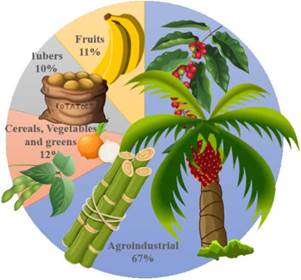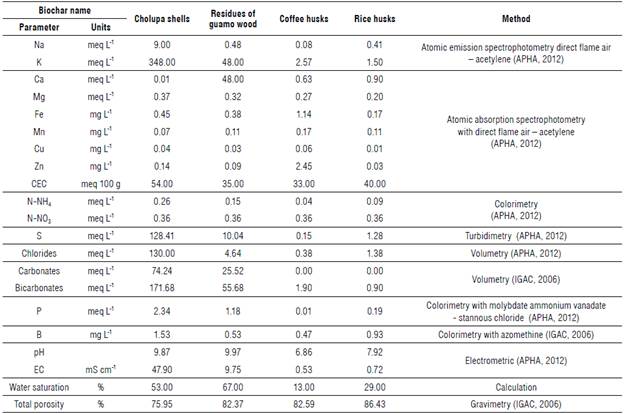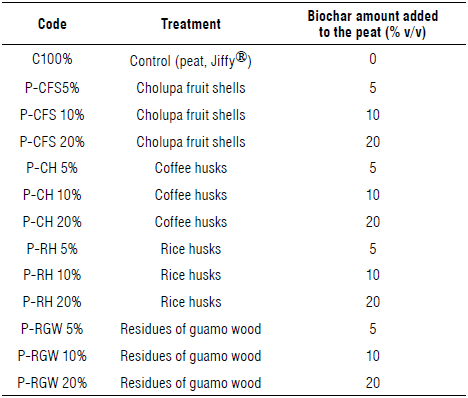Introduction
Throughout 2019, 63 million t of plant products were harvested in Colombia, with a predominantly agro-industrial crop distribution (Fig. 1) with palm oil, sugarcane, and coffee standing out (DANE, 2020). This production inherently generates waste with a negative impact on the environment (González, 2013; Penaranda et al., 2017) and creates high costs for its final disposal (Cury et al., 2017), mainly associated with the precarious technologies in the country for waste utilization (González, 2013; Vargas & Pérez, 2018).
There are different biological, chemical, and thermal treatments that could add value to these biomass residues, obtaining benefits such as the development of agricultural substrates and fertilizers, generation of energy, or production of livestock feed supplements, etc. Specifically, one of the benefits is biochar synthesis by heat treatments (Garrido, 2017; Rueda-Ordonez & Tannous, 2017) implemented as edaphic substrates in agricultural crops.
Studies carried out on wheat, corn, and tomato showed that the amendments of biochar into the soil increase reserves of carbon, nitrogen, phosphorus (Zhang et al., 2020) and the pH of acid soil (Machado et al., 2018), and increase root growth, improving plant height, stem diameter, and fresh weight of its components and fruits (Agbna et al., 2017) that finally increase crop yields.
Originally, the biochar found in the soil originated from kitchen scraps and wildfire. Farmers add food scrap-derived biochar to the soil of their plantations because they have no access to biochar production technologies, making it pertinent that the project developed a flame curtain kiln for production of biochar, implementing conditions used by farmers (Glaser et al., 2001).
Previous studies promoted the development of this research that focuses on the production and use of biochar to evaluate its effect on the growth of granadilla (Passiflora ligularis Juss.) seedlings in the department of Huila in Colombia. This plant has great economic importance and productive interest (Ramírez et al., 2021) with 19,000 t of fruit harvested in 2019 (DANE, 2020). Specifically, this study focuses on an analysis of the growth parameters of granadilla seedlings (dimensions, mass, and chlorophyll index) as a function of the type of biochar and its concentration in the substrate.
Materials and methods
Types of biomass
The choices of biomass used to produce four different biochars were derived from residues from the agro-industrial sector of Huila department: cholupa (Passiflora maliformis) fruit shells, residues of guamo (Inga spuria) wood, coffee (Coffea arabica) husks and rice (Oryza sativa) husks. Each type of biomass was gathered in San Agustín (Huila, Colombia), except for the cholupa shells, gathered in Rivera (Huila, Colombia). The pulp and mucilage were removed from the cholupa fruits, and the shells were washed with water. Biomass was subjected to tray drying without convection at room temperature (30°C).
Biochar preparation
A conical flame curtain kiln was used for biochar production. The conical kiln was built by researchers at the Ithaka Institute following a design proposed by Smebye et al. (2017) and Stadler and Perteguer (2018). Adjustments to the support structure were made in order to make the equipment mobile, and the thermal insulation system was modified to a sandwich type (Fig. 2).

FIGURE 2 Flame curtain conical kiln: A) front right layout view, B) front left layout view, and C) rear left layout view. Cone dimensions: upper base diameter of 135 cm, lower base diameter of 48.4 cm, height of 75 cm, and volume of 500 L.
The conical kiln allowed the compaction of the biochar at the bottom of the structure as well as the maintenance of a large surface flame that isolated the pyrolytic process from oxygen (Smebye et al., 2017). The conical kiln was loaded with a volume of approximately 10% (25 L) of the biomass to be processed. It was ignited with a match to obtain a steady flame (around 15 min). Then, the leftover biomass (225 L) was introduced to the flame curtain for 90 to 120 min at an average of 400°C to 500°C.
The reaction was finished by adding water. First, the product was dampened; then the water from the reactor was drained in order to obtain the biochar. A sample of each biochar was sent to the laboratory for a saturation extract analysis in soluble phase (Tab. 1).
Plant material and growth conditions
Seeds were obtained from the mature granadilla fruits from a 2-year-old crop located in Huila department. The fruits were disinfected with a mixed solution of Agrodyne SL, 132 g L-1 of polyethoxy-polypropoxy iodine and polyethoxy ethanol (Electroquímica West S.A.) with an added dose of 5 cm L-1 of water. Subsequently, the fruits were depulped, and the seeds were suspended in Pectinex® Ultra SP-L (3800 PGNU/ml polygalacturonase, Novozymes®) with a dose of 0.5 g L-1 per 100 g of pulp added for 150 min and washed with water. Then, the seeds were spread on a tray lined with Kraft paper at room temperature in the dark for 8 d. Finally, the seeds were stored from 15 to 20 d at 4°C.
Plant propagation from seeds was carried out in polystyrene trays with 50 holes (16 cm deep and 0.15 L) filled with Jiffy® peat (Jiffy group, the Netherlands) plus the addition of each biochar corresponding to each treatment (Tab. 2), using two seeds per hole. The trays were then transferred to the germination chamber for 15 d and, subsequently, trays with germinated seedlings were arranged in the nursery according to the treatments. Thinning was carried out over 20 d after sowing, leaving 50 seedlings per tray.
Air temperature was maintained from 15°C to 23°C. Phytosanitary management was carried out with an application of copper oxychloride (equivalent to 35% Cu, Grupo Agrociencias LTDA.) at a dose of 2 g L-1 and Mertect 20SL (220 g L-1 of Thiabendazole®, Syngenta, Colombia) at a dose of 1 cc L-1 at 20 d after sowing, and foliar applications of copper oxychloride and Ridomil Gold® MZ68WP (4% of Metalaxyl-M + 64% of Mancozeb®, Syngenta, Colombia) with doses at 1.5 g L-1. Mineral nutrition management was scheduled through foliar applications and substrate fertilization starting from 27 d after sowing with applications of Master 13-40-13 (NPK), CRECIFOL® (100 g L-1 of total Nitrogen, 300 g L-1 of P2O5 and 100 g L-1 of K2O, BIOEST®), and Safer Mix® (Beauveria bassiana 4x108 spores/g, Metarhizium anisopliae 4x108 spores/g, Lecani-cillium lecanii 1x108 spores/g, Bacillus thuringiensis 1x108 spores/g, SAFER Agrobiológicos S.A.S.) with doses dependent on the development of the leaves of the seedlings. The irrigation dose was approximately 100 L m3 of substrate, with daily irrigation.
Treatments and analyzed variables
For each treatment depicted in table, 2100 seedlings were grown. Twelve samples of each treatment were employed to made destructive observations at 3 perods: 43, 57, and 71 d after sowing.
For each sampling, the chlorophyll index was obtained from the last developed true leaf using a portable chlorophyll meter (SPAD-502, Konica Minolta, Inc., Japan)). Subsequently, the seedlings were washed down to the bare roots. The root length (cm) was then taken from the beginning of the main root to the length that marked the longest secondary root, the leaf number was counted, the stem length (cm) was measured from the base of the seedling to the height of the last developing leaf, and the basal diameter (mm) was measured 3 cm above the base of the seedling. The seedlings were dried at 75°C for 48 h and the root dry weight (g), leaf dry weight (g), stem dry weight (g), and total dry weight (g) were measured.
Statistical analysis
The data were analyzed using the Kolmogorov-Smirnov normality test. The distribution of the evaluated variables was normal, then the measurement frequencies of the total dry mass to a histogram was adjusted by deciles, normalizing the area under the curve (equal to 1) to obtain the density function that was compared against a normal density function for the same sample mean and deviation. The homogeneity of variances was analyzed with Levene's test. Subsequently, a factorial analysis of variance and the Tukey's multiple comparison test (α=0.05) were performed.
Results and discussion
After 43 d the sample seedlings still had cotyledons, and at 57 d the plant roots had reached the bottom of the containers (16 cm deep). At 71 d seedling growth was evident by the development in both its length and diameter. On d 43 and d 57 there were no statistical differences between the treatments; and, therefore, the discussion of the results focused on the differences found for d 71.
The morphological parameters for growth evaluation were obtained for the leaves, stem, and roots in each sampled seedling (Fig. 3).
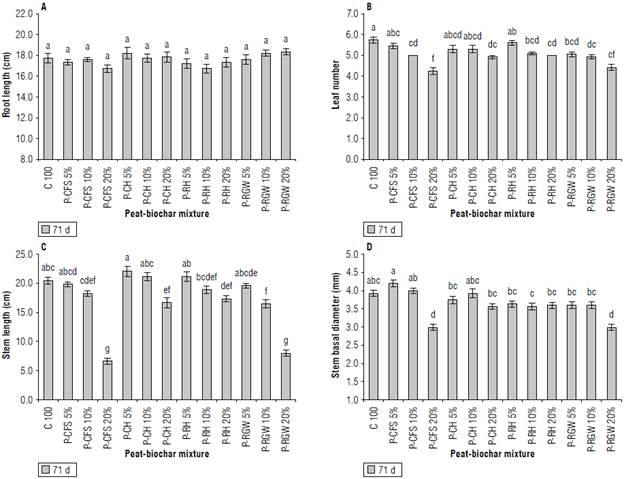
FIGURE 3 A) root length, B) leaf number, C) stem length, and D) stem basal diameter of granadilla seedlings grown on different peat-biochar mixtures at 71 d after sowing. Significant differences (P<0.05) among treatments are indicated by different letters according to the Tukey's test. The vertical bars in each average indicate the standard error (n=12 seedlings). See codes of peat-biochar mixtures in Table 2.
According to the total dry matter, the influence of the type of biochar on the growth of the seedlings showed variations without exceeding the control treatment. However, the addition of 5% of the biochar derived from the cholupa fruit shells showed a superior effect among the four types of biochar (Fig. 4), but at higher concentrations it has an opposite growth effect. The highest concentrations of coffee husk biochar did not generate inefficiency in seedling development.
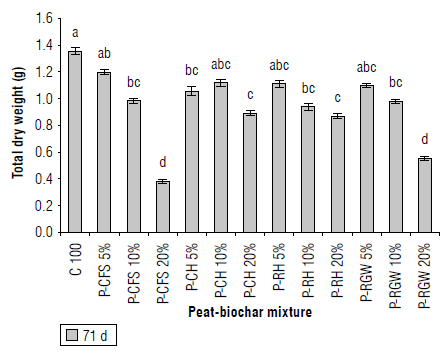
FIGURE 4 Effect of thirteen treatments on dry matter of seedlings of granadilla at 71 d after sowing. Significant differences (P<0.05) among treatments are indicated by different letters according to the Tukey's test. The vertical bars in each average indicate the standard error (n=12 seedlings). See codes of peat-biochar mixtures in Table 2.
Biochar derived from coffee husk contains most elements at adequate levels, with a neutral pH. However, according to the results of saturation extract analysis in soluble phase, the levels of zinc in the biochar were high. Zinc in high concentrations is toxic to plants (You et al., 2021). The treatments with biochars derived from cholupa fruit shells, coffee husks, and rice husks did not differ from one another; their pH showed a tendency to be alkaline and could reduce the availability of minor mineral nutrients for the plants.
According to Santos et al. (2020), root growth depends on the electrical conductivity and pH of the substrate. Figure ЗА shows the effect of the type of biochar on root growth, whose vertical growth stops once the length equaled that of the container, although the development of dry matter of the plant continued. At 71 d, a positive effect on the length of the root was clear due to the biochars derived from rice and coffee husks that have medium levels of electrical conductivity, contrasting to those derived from cholupa fruit shells and guamo wood residues.
The high concentration of biochar in the substrate had negative effects on the granadilla seedlings because of its effects on the plant dry matter. The concentration of 20% of the different types of biochar caused lower growth. In addition, the analysis of the saturation extract of the biochars showed that biochar derived from cholupa fruit shells and guamo wood residues contained excessive levels of potassium, chlorides, and sulfur.
Chrysargyris et al. (2019) finds that biochar from wild bamboo and wood sieves at high levels (15 and 20%) negatively affects dry matter and root length of cabbage seedlings. However, at 71 d of the present study, the addition of biochar had positive effects on root length, without exceeding the root dry matter generated by the control treatment.
The addition of 5% of biochar did not lead to an imbalance that would cause negative effects on the seedlings. The means by which seedling propagation is carried out is equivalent to one of the highest production costs, so this study was an approximation to the equivalences in which biochar can be used.
The analysis of the leaf number and chlorophyll index in the granadilla seedlings indicated that the biochar derived from guamo wood residues was the substrate that generated the lowest leaf numbers. The lowest chlorophyll index in the three samplings was obtained from biochar derived from cholupa shells, and the best response was obtained from the coffee and rice husks.
The effect of chlorophyll directly impacts plant growth, and it is related to the leaf area. Likewise, chlorophyll levels are an indicator of the plant's ability to produce carbohydrates. The results regarding this parameter indicated that the biochar treatments derived from coffee and rice husks did not generate an imbalance in the substrate. According to analysis of the biochars, they have a lower sum of cations than those derived from guamo wood residues and cholupa shells that have cations in excess.
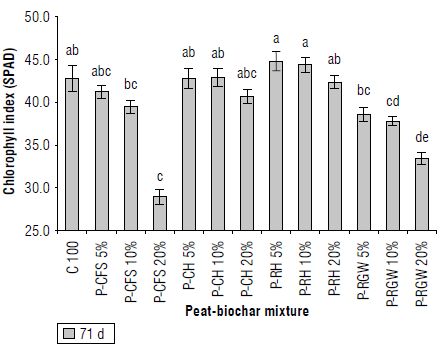
FIGURE 5 Effect of thirteen treatments on chlorophyll index of seedlings of granadilla at 71 d after sowing. Significant differences (P<0.05) among treatments are indicated by different letters according to the Tukey's test. The vertical bars in each average indicate the standard error (n=12 seedlings). See codes of peat-biochar mixtures in Table 2.
The results are presented by comparing the chlorophyll index and the leaf number in the three sampling moments. These results agree with the findings of Chrysargyris et al. (2019), since the chlorophyll index (SPAD) in the cabbage seedlings is affected differently by the type and proportion of biochar with decreases often more pronounced at higher levels of biochar (15 and 20%). On the other hand, Bommaraju (2016) finds that the substrate constituted by vermicompost and biochar from forest residues (50% biochar and 50% vermicompost) improves photosynthesis in coffee seedlings.
Conclusions
This study showed the effect of the type and different concentrations of biochar as substrate on growth parameters of granadilla seedlings. The analysis of the type of biochar demonstrated that those from materials such as rice husk and coffee husk showed superior results on the growth of the plants, thus, showing that their effect on the substrate generated a positive impact at low concentrations.The bio-mass that had the greatest results for biochar production as a substrate is coffee husk. The results were also conclusive regarding the concentration of biochar in the substrate, where 5% had the greatest effectiveness, but they did not exceed the control treatment.The control treatment had the best result because the peat used is a substrate of natural origin specially conditioned for seedling propagation, implying that the high concentrations of biochar unbalanced the base conditions of the substrate. However, biochar has effects that should continue to be studied in combination with other organic substrates such as soil and coconut fiber.













